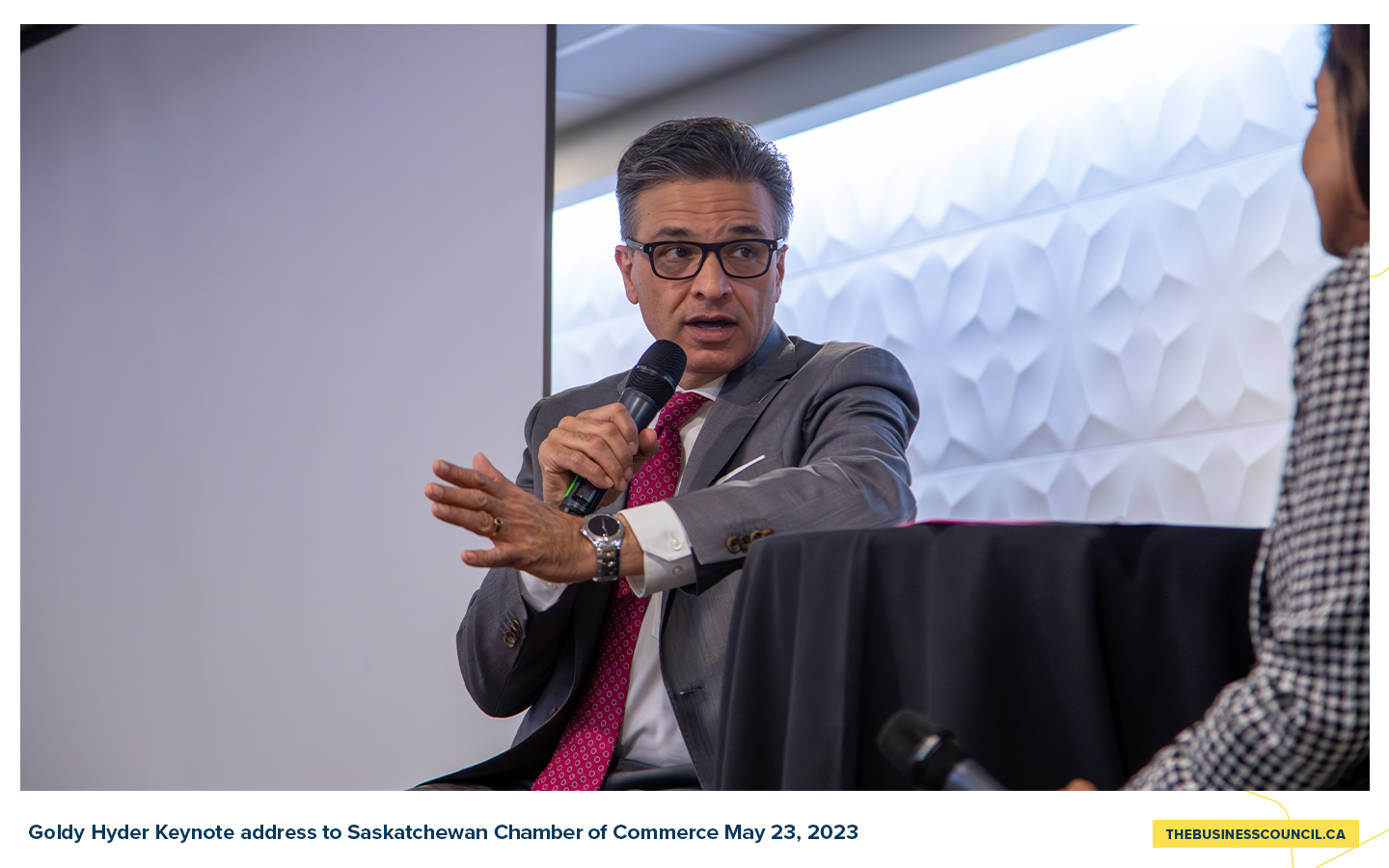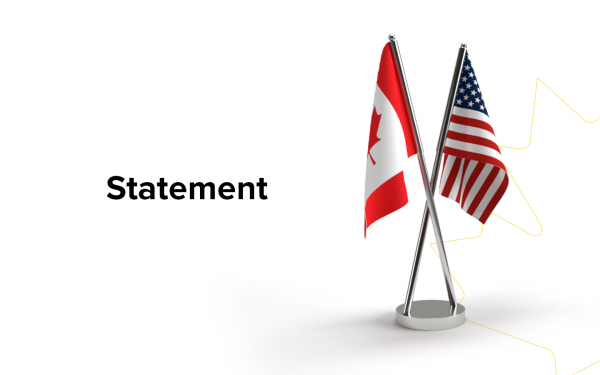Building our future: A call to action
Goldy Hyder Keynote address to Saskatchewan Chamber of Commerce May 23, 2023
It’s great to be back in Canada’s heartland and to reconnect with so many familiar faces.
You may know that I’m a proud Westerner.
Every time I make it back home, I get re-energized.
Maybe that’s because when you’re in Saskatchewan or Manitoba or Alberta, you see first-hand Canada’s economy in action.
You can’t drive through the Prairies without spotting a wheat field … or an oil well … or a train cutting across the landscape, delivering goods across the country and to markets overseas.
In the Prairies you truly appreciate that Canada is blessed with the resources that can feed and fuel the world.
Think about all that Saskatchewan has to offer.
- The high-quality grains and pulses that people around the world rely on for food
- the potash that enables farmers to increase their yields
- the oil and gas that powers our economy
- the uranium that is essential to clean-air nuclear energy
- the ag tech that will drive sustainable farming around the globe
- and the people who make it all happen … the people who lead and innovate and solve problems.
And yet in the midst of this bounty, I’m worried.
Looking at those trains crossing the country, I often wonder if we would be able to build a trans-Canada rail line today.
Do we still have the vision and the support to build large infrastructure projects such as highways and bridges, ports and pipelines, rail terminals and electricity grids, wind, and solar power systems?
I’m talking about export-enabling economic infrastructure that crosses multiple jurisdictions and generates well-paying jobs in different parts of the country not just during construction, but for years to come.
I often refer to these projects as the arteries of our economy.
This is the infrastructure that enables Nutrien – the world’s largest crop nutrient company – to commit to its mission of “feeding the future” – sharing more than 27 million tons of potash, nitrogen and phosphate with customers around the globe.
It is the infrastructure that Canpotex relies on to deliver potash to 40 countries.
We are a trading nation. Sixty per cent of our GDP relies on trade. But I have real questions today about whether we can get our goods to market effectively and efficiently.
And I wonder if we have the commitment to the massive energy transition projects that are so vital to a low carbon emissions future.
Our recent track record isn’t great.
You may remember last August; the Chancellor of Germany came to Canada with a delegation of senior business leaders.
Facing severe energy shortages due to Russia’s unjust war in Ukraine, the Germans hoped we would help them offset their reliance on Russian energy by building liquified natural gas export infrastructure in Atlantic Canada.
We were Germany’s first port of call. They wanted to import the energy they desperately needed from Canada – a like-minded country which shares their values.
But when Chancellor Olaf Scholz got here, Canada’s federal government had a different plan in mind.
Rather than talking about how to get LNG to Germany, our government preferred to look to the future, and talk about plans to develop hydrogen and renewable energy.
With winter on the way, Germany couldn’t wait.
Two weeks after Scholz’s visit to Canada, Germany’s largest importer of natural gas signed a 16-year contract to purchase LNG from an export terminal in Australia.
Since then, Germany has signed other import agreements, including with the United Arab Emirates, Qatar, and the United States.
And to accommodate the new sources of energy, Germany built LNG import terminals in record time.
They recognized the urgency to get infrastructure built quickly.
Did Canada blow an opportunity? Absolutely.
Instead of showing leadership – instead of building the infrastructure that’s required to take advantage of Canada’s abundant energy supplies – we sat on our hands.
Worse, we turned our backs on our friends.
Sadly, this was not an isolated incident.
In February Japan’s ambassador to Canada said the world is waiting for us. He urged Canada to play an important role to support not only Japan’s energy needs, but those of other countries.
When I visited Korea a year ago, a senior government official accused Canada of ‘hoarding’ our resources – keeping them to ourselves for our own benefit to the detriment of our allies.
They couldn’t conceive of the possibility that the real reason was we couldn’t get our act together to build the export infrastructure required to get our resources to market.
Other diplomats I speak with share the same confusion. Why would a country rich in natural resources be so incapable of sharing its products?
Now, the federal government may argue that when it comes to approving new major projects, it’s focused on the future. Its priority is on the clean energy projects we’ll all be relying on to power our economy in 2050.
My message to the government is it’s not an EITHER / OR proposition. We should be able to invest in lower emissions projects AS WELL AS renewable infrastructure.
And speaking of renewables …
Just a few weeks ago, a tidal energy project pulled the plug on its operation in the Bay of Fundy. Sustainable Marine aims to help coastal communities achieve energy independence and fight climate change by harvesting clean energy from tidal waters.
What better place to set up than in the bay that sees the highest tides in the world?
Sustainable Marine invested millions in the project and also received millions in federal funding – that’s our taxpayers’ dollars at work.
And the technology was working. It was actually putting energy back into Canada’s power grid.
But now the project is scuttled. The company says a lack of transparency and no viable regulatory pathway at the federal level has led to suspending the project.
For a country that is anxious to support the transition to cleaner energy, this is what I can only describe as an “own goal.”
In April, the President and CEO of the U.S. Chamber of Commerce, Suzanne Clark, visited Ottawa. In a keynote speech she lamented the slow permitting process in the United States. She told us it takes an average of seven years to approve most projects … ten years if the project is complex.
My reaction? I wish it was that fast in Canada!
And I’m watching with envy U.S. Senator Joe Manchin’s push to speed up the permitting of energy projects south of the border.
Can you imagine a two-year deadline for major energy project reviews? It’s incredible.
Natural Resources Minister Jonathan Wilkinson has said repeatedly that it takes an average of 12 to 15 years to open a mine in Canada. He recognizes that’s too long, saying “it is clearly the case in this country that we need to find pathways to develop projects more rapidly than we have in the past.”
I think we would all agree.
We all know that companies aren’t prepared to wait for a slow and unpredictable approval process. They have other options, including outsourcing, automating and relocating.
So what’s the problem? Why is it taking so long to get essential projects past the finish line?
Canadians used to be great at building things.
The country we know today – the modern, advanced economy that provides Canadians with a high quality of life and is a magnet for people from around the world – it wouldn’t exist if it hadn’t been for leaders who thought big and built even bigger.
Think of the Trans-Canada Highway. When completed in 1962 it was the longest uninterrupted highway in the world, spanning almost 7,500 km from the Atlantic Ocean to the Pacific and passing through all 10 provinces of Canada.
Think of the St. Lawrence Seaway, one of the world’s most heavily used international trade routes. When the Seaway opened in 1959, it represented the final link in a waterway almost 3800 km long, from the westernmost point of Lake Superior to the Gulf of St. Lawrence.
Think of the TransCanada pipeline, known today as the Canadian Mainline. It had the distinction of being the longest pipeline in the world until the 1980s.
These projects have all been vital to the life of our country.
But do we still have the vision and the commitment to build the modern infrastructure our country needs? The infrastructure that connects supply chains, enables people and goods to move freely, provides low-carbon energy, supports millions of jobs, and ensures that our economy continues to grow?
I’m not so sure.
In some respects, the federal government is saying the right things.
When she delivered her latest budget in March, Finance Minister Chrystia Freeland said “We’re going to build big things here in Canada.”
Those words echoed other assurances we’ve heard over the last year.
In August, the Prime Minister said he was open to easing processes to allow certain major projects to move through regulatory hurdles more quickly.
In October Minister Freeland told a Washington audience that Canada must – and will – fast-track certain types of energy and critical mineral projects.
Based on those signals, we had high hopes for the 2023 budget.
And yet, in March, all we got was more words.
The budget commits to outlining a plan … by the end of the year … “to improve the efficiency of the impact assessment and permitting processes for major projects.”
Why are we waiting?
If the government needs ideas on how to improve the system, I’ve got a bunch to share.
Earlier this year, the Business Council released its latest report on Canada’s energy transition.
Innovate, compete and win offers a practical roadmap for how the public and private sectors can work together on Canada’s economic and environmental security.
It includes clear and simple guidelines for the regulatory approval process.
We are calling on the government to prioritize approvals for projects that meet one or more basic criteria.
- Does the project contribute to global energy security?
- Does it help lower emissions either in Canada or abroad?
- Does it unlock and process minerals critical to the energy transition?
- Does it have Indigenous leadership, ownership, or support?
Sounds pretty basic, doesn’t it?
What’s more, the private sector is already leading the way. Large employers are making commitments to help Canada and other countries achieve net zero emissions by 2050.
And they are taking the lead in advancing economic reconciliation, creating enduring relationships with Indigenous peoples.
Look at the formal collaboration agreements Cameco has with the First Nations it works with in Northern Saskatchewan, where half of its workforce is Indigenous. Cameco’s operations in the north are focused on five pillars:
- workforce development,
- business development,
- community investment,
- community engagement and
- environmental stewardship.
Or how about BHP’s Jansen potash mine? In March BHP signed contracts with Indigenous suppliers valued at over 260 million dollars. The contracts will support more than 400 local jobs, at least 50 per cent of which will be Indigenous.
Then there’s Harvard Development’s Currents of Windermere project in which almost 15 hundred solar panels are being installed on the rooftops of three retail buildings in Edmonton. Once complete, the panels will produce almost 700 thousand kilowatt hours per year of electricity.
And look at the collaboration between Saskatchewan universities and startups to research and develop innovative new ag-tech that is improving the yield, nutrition and sustainability of crops.
This is leadership in action from the private sector.
But we need willing partners from the public sector.
We need all levels of government to work together with employers to expedite projects that will benefit all Canadians.
I’m encouraged by developments with the Cedar LNG project in B.C.
Once completed, the Indigenous-owned facility will be able to liquefy and export three million tonnes of LNG per year – destined for markets in Asia.
In March the B.C. government approved the project and the federal government quickly followed suit.
That’s because the province and the feds developed a substitution agreement – allowing both governments to decide on a project based on ONE assessment.
One project, one review. That’s a good template to follow.
The approval comes with conditions – 250 of them in fact. That’s to be expected. And the project is still awaiting some more permits before starting construction. But the federal, provincial, and Indigenous cooperation should be acknowledged and applauded.
We need more of that because there’s a lot of work ahead.
We must look to the future and plan our infrastructure needs for years to come.
Our infrastructure should LEAD growth. Instead, right now we’re caught in a cycle of infrastructure TRYING TO CATCH UP to growth and demand.
The to-do list is long:
We need expanded ports and modern transportation infrastructure to trade with the rest of the world – our allies are counting on it.
We need cutting-edge digital infrastructure that enables Canadians to push the boundaries in everything from artificial intelligence to automation, the Internet-of-things, the metaverse, quantum computing, and augmented reality.
We need an estimated 5.8 million new homes by the end of this decade to meet the anticipated growth in our country’s population and enable better matching of households with the housing they need and can afford.
We need to build out Canada’s electrical vehicle charging infrastructure along highways and where Canadians live, work and play, to support EV adoption and the goal of a net-zero future.
We need a plan to access, extract and process minerals that are critical to the energy transition.
We need to at least double the production of electricity in Canada as we replace many uses of fossil fuels with clean electricity.
We need all of these, and much more, for Canada to achieve its potential, and for future generations of Canadians to enjoy the high quality of life they deserve.
As employers, we have a role to play.
We need to do a better job telling our stories.
We are leaders.
Speak to your elected representatives.
- Share with them what YOU are doing to help grow the economy.
- Let them know the impact that approval delays are having on your bottom line.
And – I know this sounds so basic – but remind politicians and others about the positive impact businesses have on their communities. We are the employers who generate the jobs, the incomes, the revenues, and the tax base that supports everything we value here in Canada – our hospitals, our schools, our social programs and … yes … our infrastructure.
I’m an optimist, but nation-building doesn’t happen by itself.
It requires partnership and leadership.
The leadership to imagine.
The leadership to plan.
And the leadership to build.









